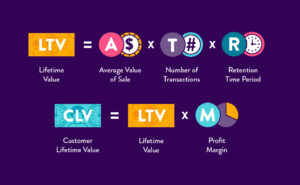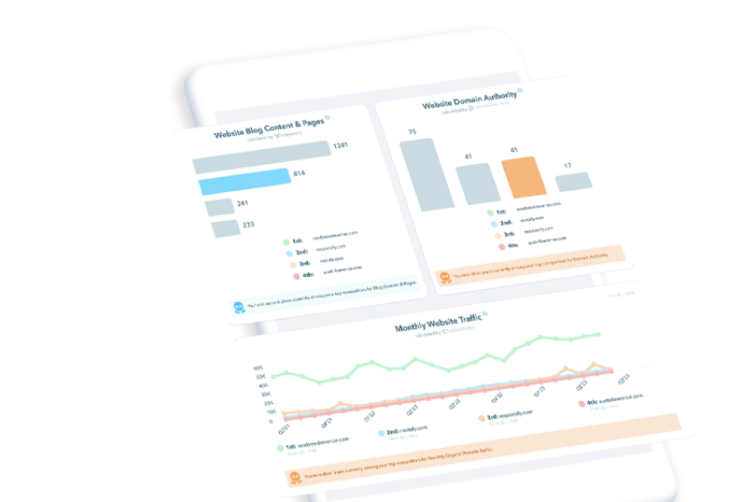 22109 Views
22109 Views  6 min read
6 min readAt Responsify we help our clients attract new customers by leveraging Inbound Marketing. To help them get the most out of their marketing budget, we gather a metric called Customer Lifetime Value, also known as CLV. This metric helps determine the best strategy to attract and close their highest yielding customers, so they can grow their business as fast as possible. In case you need a hand calculating your Customer Lifetime Value (CLV), we made this post to help you do just that! Check out how to find your CLV calculation below.
Customer Lifetime Value is a metric that represents an educated estimate of the financial value a business will acquire from its entire relationship with a customer.
For companies interested in growth (that’s you!), the CLV is an important metric. When you put it up against your customer acquisition cost, you can better see how much time it will take to get a return on your investment with a new customer. These costs for acquisition can include anything from sales, to marketing, to operations, and even the cost of making the product that you are trying to sell.
Find out more on the ins and outs of customer lifetime value in the video below:
When you have the full CLV picture, you’ll be able to get and keep highly valuable customers.
If you sell multiple services, you may have multiple customer segments. You don’t need lots of spreadsheets and math experts to figure it out, though. The formula can be easily broken down based on your customer information.
Of course, the CLV is a projection, so it means that you have to make a few educated guesses based on previous history. You can use historical data to get a better sense of what the CLV might be.
First, you’ll want to calculate the value for each segment, and then average them together if needed. We created this graphic CLV calculation formula:
In other words, for your CLV calculation, you need to find the average order value and multiply it by the customer’s repeat purchase rate. This will give you the customer value. Subtract their acquisition cost to determine their full lifetime value as a customer.
Still trying to figure it out? Let’s break the customer lifetime value calculation down even more.
You can find the average order value by diving your organization’s complete revenue over a certain time period (a year, for instance) by how many purchases are made during that time. Find your customer’s repeat purchase rate by dividing the number of buys by how many unique customers you have (during that same time period). From there, find your customer value by multiplying the repeat purchase value by the average purchase rate. Then, you can find the customer lifetime by taking the average number of years a customer sticks with the company as a buyer. Finally, multiply your customer value by the lifespan. This is the expected revenue for the customer during their full relationship with your company.
Why is it important to calculate my company’s CLV metrics?
Your CLV calculation formula is one of the most critical metrics to gather as you develop your business. Your customer lifetime value calculation helps your team make more informed business decisions, determine sales and revenue potential, and align your marketing and sales efforts. It’s important to note, your CLV may change as your business evolves. Updating it annually or even quarterly can help sharpen your business’ focus.
If you don’t know your CLV, you won’t know if what you’re doing–when it comes to marketing, sales, and customer loyalty–is working. Without this, there is no way to strategize the most effective marketing tactics and help your staff create the best materials and strategies to keep customers longterm. At the end of the day, too, it is way more expensive to get new prospects and clients. It is much cheaper to keep the ones you’ve got. Therefore, it’s critical to assess your customer’s value, boost that value, and keep that value.
Your CLV is an indicator of how much revenue you will likely see from any one customer over their time with your company. If they continue to buy from you, their CLV will be higher. You can keep this value high through excellent customer service and support. Offering solutions to problems and giving recommendations that will help customers will increase their likelihood of staying loyal to your brand.

The CLV can help you predict if the customer will be a repeat customer, or if they are a one-and-done sale. If you notice they have a high CLV, you can likely determine that the customer will buy again and that their loyalty is on the high side.
On the flip side, not paying attention to these things can hurt your CLV and increase the chances that you will lose the customer. A customer must feel like they are being taken care of by the company and should be able to get a sense of brand loyalty. Brand loyalty is extremely critical when it comes to retention rates. If a customer is loyal to your brand, they will tell their friends. These customer cheerleaders are helpful for free marketing. The more loyal the customer, the higher the customer lifetime value.
And, because your revenue is often dependent on the rate of your sales and marketing costs, you will need to make sure you have optimized both costs for scale. For instance, if your revenue goes down, but your marketing and sales costs keep going up, you lose out on some profits. Therefore, you need your marketing and sales to grow as the company grows. Watching these numbers will help you better understand your full CLV calculation.
If you need help calculating your company’s CLV metrics, feel free to book a time to speak with us. We’re happy to help any way we can!
If you’ve crunched the numbers and your current CLV is low, don’t worry. There are ways to ramp up your CLV and make the most out of your relationships with your customers. It all starts with creating the best customer experience to encourage them to stay with you.
First, this means you need to communicate with them in a way that will increase their bond to you. Giving them a way to contact you when they need it will build on your relationship and humanize your company in their eyes. If they have questions, give feedback, or raise a concern, connect with them as soon as possible to see what you can do.
This will make your customer feel like they are valued and that their needs matter to you. Knowing that they can come to you with their needs will encourage them to buy from you again and again, raising the customer lifetime value. Make sure your marketing tactics are up to par and delivering the best messages to your customers to entice them to come back.
Another way to keep customers coming back and loyal to your brand is with a literal loyalty program. This will make their experience with your company one-of-a-kind and will help make them feel special. If they make a repeat purchase, consider giving out reward points or other incentives. Maybe a discount for their next buy or even a freebie. If customers are accumulating rewards, they will be less likely to want to leave (and leave the rewards behind!).
Don’t forget to start your customer retention plans to increase the customer lifetime value from the very beginning. Every interaction a customer has with your brand is important, starting with the very first. Reach out with additional information on your products, the company, and what you offer. Make sure the customer knows of all available features and benefits and how your product stands out from the rest. Especially for first-time customers, it is crucial to show you will always be there to answer any questions or concerns.
Remember the CLV is crucial when thinking about what the future looks like for the company and how much you will grow. Instituting some ways to increase CLV and prioritizing it is very important.
You know it’s important to show that your product is the best and that you will always need to increase your company’s revenue. That doesn’t always translate to you wanting to spend time working out formulas and lifetime values, though. We get it.
But it’s important. First, it can lead to better retention. Every time a customer comes back, your revenue increases. What’s more, you haven’t churned a customer. CLV also helps you reward repeat buyers. Lastly, it will ultimately lead to more revenue and better loyalty from your customers.
So you’ve done the CLV calculation. Now what? Well, now you need to use that information to enhance and maintain your CLV.
Continue to build customer loyalty by building out targeted, valuable content. Make sure to connect with them on a personalized basis to make them feel special and make them want to return.
You should also make sure to keep this content individualized as they move through their lifetime as a customer. Make sure it keeps them entertained and enticed to keep coming back. Take note of their previous buying habits and connect with them based on what they are likely to do next.
You can connect with them via multiple channels, too. Online, in-person, and via mobile are all ways that customers shop, so don’t stick to just one and neglect the others. Use social media, paid ads, and email to further reach out and build loyalty. This will definitely boost your chances of a longer CLV.
